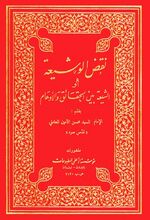Naqd al-washi'a (book)
 | |
| Author | Al-Sayyid Muhsin al-Amin |
|---|---|
| Original title | نَقْضُ الْوَشیعَة اَوِ الشّیعَة بَیْنَ الحَقائقِ وَ الْاَوهام |
| Language | Arabic |
| Series | 1 vol. |
| Subject | Rejection of the book Al-Washi'a |
| Published | 1403/1982-3 in Beirut |
| Publisher | Mu'assisat al-A'lami li-l Matbu'at |
Naqḍ al-washīʿa (Arabic: نَقْضُ الْوَشیعَة) also known as al-Shīʿa bayn al-ḥaqāʾiq wa l-awhām (Arabic: الشّیعَة بَیْنَ الحَقائقِ وَ الْاَوهام) is an Arabic book written by al-Sayyid Muhsin al-Amin. In this book, the author responds to criticisms of Shia beliefs by Musa Jar Allah in his book, al-Washi'a. Allama al-Amin objects to Jar Allah for writing the book and tries to respond to all his criticisms in a well-argued way.
Introduction of al-Washi'a
Al-Washi'a fi naqd 'aqa'id al-shi'a is a book written by Musa Jar Allah, in which objections are made to Shia beliefs. He travelled to the two Shia countries, Iran and Iraq, and based on his observations and previous studies, he wrote an essay and published it in Najaf. The essay is titled "Masa'il Jar Allah," in which twenty questions are posed as objections to Shi'a beliefs. The essay was read by some Shia scholars such as al-Sayyid Hasan al-Sadr in Kadhimiya. In his al-Washi'a, Jar Allah elaborates upon questions he raised in that essay. Concerning some issues, he speaks sarcastically of the Shia community, Shia scholars, and even some Imams (a) of the Shi'a.[1]
Who is Musa Jar Allah?
Musa Jar Allah is a Muslim writer and translator from Tatarstan who was born in 1873 in Rostov. Jar Allah went to school in his birthplace and continued his education in Kazan. After some academic studies, he began to study Islamic sciences. Thus, he immigrated to Cairo. He learned jurisprudence and hadith within three years. He then moved to other cities in the Islamic world, studied more, and learned Arabic and Persian. He presented a reformist and modernist image of himself by proposing new ideas and problems in Islamic conferences. Jar Allah died in 1949 in Cairo and was buried in the Khudaywiyya cemetery.[2]
Meeting between Jar Allah and al-Amin
In his travels to Islamic countries, Musa Jar Allah met with many Shia and Sunni scholars, including al-Sayyid Muhsin al-Amin, who he met twice:[3] once in Kufa in 1352/1933-4 and once again in Tehran in 1353/1934-5 for three days. In the Kufa meeting, Jar Allah asked Allama al-Amin about taqiyya (precautionary dissimulation) and temporary marriage, and why they are considered as legitimate by Shi'as, and al-Amin gave answers to his question.[4]
Structure
In the preface of the book, Allama al-Amin points to his meetings with Jar Allah and criticizes him because he could continue his debate with al-Amin in the meetings if he was not convinced by al-Amin's responses. In this case, Jar Allah could receive more cogent replies and arguments.[5] Al-Amin says that he received books and essays daily that try to refresh enmities and divisions among Muslims. Such authors, al-Amin says, do not observe the manners of debate, curse their opponents, and make false remarks. He refers to al-Washi'a fi naqd 'aqa'id al-shi'a by Musa Jar Allah as one such writing. He says that the book is void of any scholarly discussion and that it merely contains unsubstantiated, contradictory, pointless claims which are contrary to the consensus of all Muslims, while Jar Allah says in the preface of his book that he aims to boost the friendship between Shi'as and Sunnis.[6]
Contents
The author deals with a variety of issues under 155 titles. Here are some of these titles: Friday Prayer, Qa'im Al Muhammad, tatbir, love of Ahl al-Bayt, curse, righteousness of the Sahaba, Hadith al-Manzila, Hadith al-Ghadir, integrity of the Qur'an, taqiyya (precautionary dissimulation), problems of inheritance, women in Iran, divorce, ghusl, mash, raj'a, khums, zakat, tafwid, bada', ghulat, mufawwida, miracles of the Imams (a).[7]
Style of Writing
After articulating an objection, Allama al-Amin provides brief or elaborated responses, given the significance of the issue. He usually begins with a counterexample or counterargument, and then provides a positive response. Since there are repetitions in al-Washi'a, al-Sayyid Muhsin al-Amin tries to gather the repetitive issues in one section and reply to them with arguments and citations from Sunni sources. In some cases, he goes beyond argumentation and apology and starts to object to the author himself.[8]
Publication
Naqd al-washi'a was published in 1403/1982-3 in Beirut in Mu'assisat al-A'lami li-l Matbu'at.[9]
Notes
- ↑ Ranjbarī Ḥaydarbāghī, Nigāhī bi al-Washīʿa, p. ?
- ↑ Kānlī Dara, Mūsā Jār Allāh; Ziriklī, al-Aʿlām, vol. 7, p. 320.
- ↑ Amīn, Naqḍ al-washīʿa, p. 10,11.
- ↑ Ranjbarī Ḥaydarbāghī, Nigāhī bi al-Washīʿa, ?
- ↑ Amīn, Naqḍ al-washīʿa, p. 10-11.
- ↑ Amīn, Naqḍ al-washīʿa, p. 6-7.
- ↑ Amīn, Naqḍ al-washīʿa, p. 411-416.
- ↑ Ranjbarī Ḥaydarbāghī, Nigāhī bi al-Washīʿa, ?
- ↑ Naqd al-washi'a (book) (Persian).
References
- Amīn, Sayyid Muḥsin al-. Naqḍ al-washīʿa. Beirut: Muʾassisat al-Aʿlamī, 1403 AH.
- Kānlī Dara, Aḥmad. Mūsā Jār Allāh; dānishmand wa mutafakkir-i musalmān-i Tātār. Translated by Aḥmad Ranjbarī Ḥaydarbāghī. Journal of Āʾīna-yi Pazhūhish. No 159. (1395 Sh).
- Ranjbarī Ḥaydarbāghī, Aḥmad. Nigāhī bi al-Washīʿa fī naqd ʿAqāʾid al-Shīʿa wa Raddiyyahā-yi ān. Journal of Āʾīna-yi Pazhūhish. No 160. (1395 Sh).
- Ziriklī, Khayr al-Dīn al-. Al-Aʿlām. Beirut: Dār al-ʿIlm, 1989.
- نقض الوشيعة، أو، الشیعة بین الحقائق و الأوهام (Naqd al-washi'a (book) (Persian)). Accessed: 2025/05/22.
